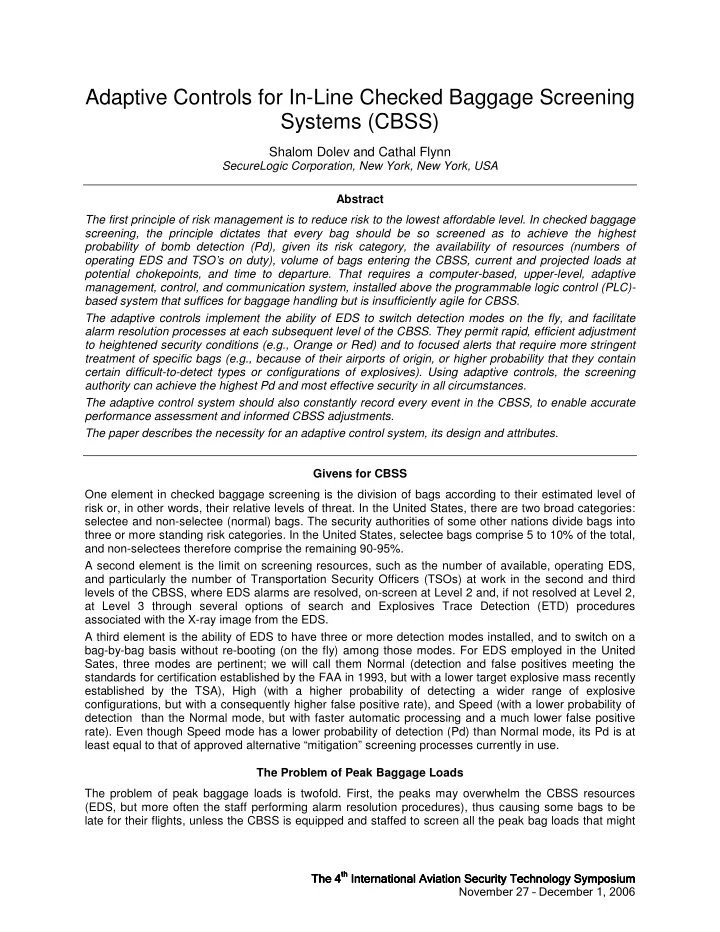

Adaptive Controls for In-Line Checked Baggage Screening Systems (CBSS) Shalom Dolev and Cathal Flynn SecureLogic Corporation, New York, New York, USA Abstract The first principle of risk management is to reduce risk to the lowest affordable level. In checked baggage screening, the principle dictates that every bag should be so screened as to achieve the highest probability of bomb detection (Pd), given its risk category, the availability of resources (numbers of operating EDS and TSO’s on duty), volume of bags entering the CBSS, current and projected loads at potential chokepoints, and time to departure. That requires a computer-based, upper-level, adaptive management, control, and communication system, installed above the programmable logic control (PLC)- based system that suffices for baggage handling but is insufficiently agile for CBSS. The adaptive controls implement the ability of EDS to switch detection modes on the fly, and facilitate alarm resolution processes at each subsequent level of the CBSS. They permit rapid, efficient adjustment to heightened security conditions (e.g., Orange or Red) and to focused alerts that require more stringent treatment of specific bags (e.g., because of their airports of origin, or higher probability that they contain certain difficult-to-detect types or configurations of explosives). Using adaptive controls, the screening authority can achieve the highest Pd and most effective security in all circumstances. The adaptive control system should also constantly record every event in the CBSS, to enable accurate performance assessment and informed CBSS adjustments. The paper describes the necessity for an adaptive control system, its design and attributes. Givens for CBSS One element in checked baggage screening is the division of bags according to their estimated level of risk or, in other words, their relative levels of threat. In the United States, there are two broad categories: selectee and non-selectee (normal) bags. The security authorities of some other nations divide bags into three or more standing risk categories. In the United States, selectee bags comprise 5 to 10% of the total, and non-selectees therefore comprise the remaining 90-95%. A second element is the limit on screening resources, such as the number of available, operating EDS, and particularly the number of Transportation Security Officers (TSOs) at work in the second and third levels of the CBSS, where EDS alarms are resolved, on-screen at Level 2 and, if not resolved at Level 2, at Level 3 through several options of search and Explosives Trace Detection (ETD) procedures associated with the X-ray image from the EDS. A third element is the ability of EDS to have three or more detection modes installed, and to switch on a bag-by-bag basis without re-booting (on the fly) among those modes. For EDS employed in the United Sates, three modes are pertinent; we will call them Normal (detection and false positives meeting the standards for certification established by the FAA in 1993, but with a lower target explosive mass recently established by the TSA), High (with a higher probability of detecting a wider range of explosive configurations, but with a consequently higher false positive rate), and Speed (with a lower probability of detection than the Normal mode, but with faster automatic processing and a much lower false positive rate). Even though Speed mode has a lower probability of detection (Pd) than Normal mode, its Pd is at least equal to that of approved alternative “mitigation” screening processes currently in use. The Problem of Peak Baggage Loads The problem of peak baggage loads is twofold. First, the peaks may overwhelm the CBSS resources (EDS, but more often the staff performing alarm resolution procedures), thus causing some bags to be late for their flights, unless the CBSS is equipped and staffed to screen all the peak bag loads that might ����� �� �� �� �������������� �� ����� ��������������� ��������������������������������������� ��������������������������������������� � ����� ����� �������������� �������������� � � �������������������������������������� �������������������������������������� � � ��������������������������� ! �
Recommend
More recommend